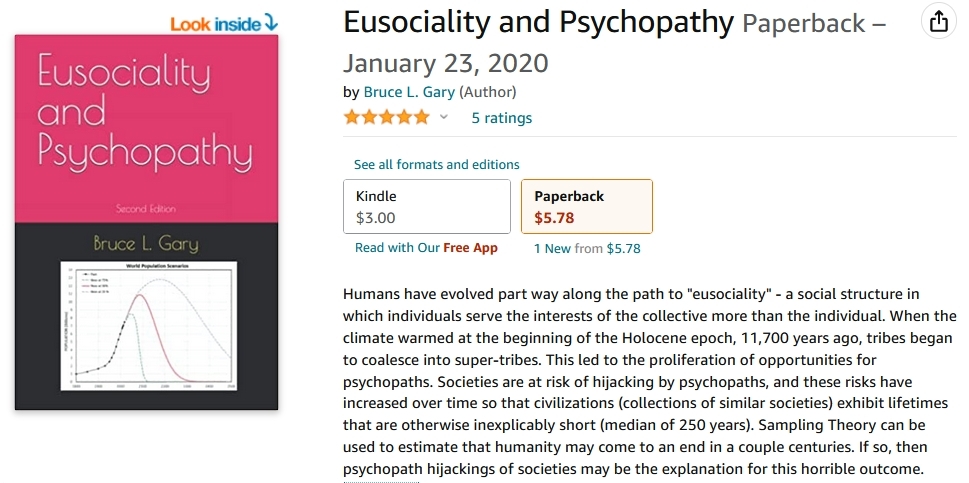
Human
Nature and Evolution
Bruce.
L. Gary
The
Ancestral Environment
Human nature has many traits that are
universal across cultures so there must be a role for our genes
in shaping this nature. Some traits can only be explained by
viewing them as an evolutionary product that serves tribal
genomes, and not necessarily the individuals created by those
genomes. For example, tribal interests are served by individuals
who exhibit amity toward fellow tribesmen and enmity toward
rival tribesmen, referred to as the “amity/enmity complex,” and
which is found in all cultures. A tribe is also better able to
compete with other tribes if it includes a variety of individual
types, such as warriors, artisan craftsmen and leaders, a
concept referred to by eusociality theory as having the merits
of “division of labor.”
Both examples can be found in other
species, such as our close relatives the chimpanzees, so there
must be genes for them that have existed for millions of years.
Every social species is to some extent “eusocialized” - an
adaptation in which individuals behave in ways that serve the
collective with no regard for individual welfare. The ants,
termites and bees are completely eusocialized, as are a total of
17 species so far identified. Most social species are only
partially socialized, and humans are one of these. Patriotism
(an extreme version of the amity/enmity complex) and division of
labor are central features of human nature.
The number of individual human types is
limited because for millions of years our ancestors lived in
tribes numbering between 100 and 200. The Dunbar Number of 150
is cited as the largest tribal population that allows for all
individuals to know each other well enough to allow for
sufficient mutual trust needed for risky tribal tasks. A typical
tribe may include 50 adult men (and similar numbers of women and
children). The tribe’s welfare will depend mostly on how well
the 50 adult men perform while defending the home tribe, or
attacking a neighbor tribe, as well as the more mundane
activities of hunting, building huts, storing food, etc.
Just as team sports have specialized
“positions” each adult male activity in a tribe will benefit
from members coming together with special abilities and
discovering what they’re good at. Inter-tribal warfare is best
conducted by teams with specialized tasks, such as a “lookout”
for monitoring enemy status, a commander for coordinating
defense or attack, providers of logistical support – and of
course front line warriors.
“Group selection” refers to collectives
of individuals competing with other collectives. For humans the
collectives are tribes. Whereas it is common to speak of tribes
competing with each other, it can be more useful to view the
competition as between “tribal genomes.” After all, every
individual is assembled by genes that are just one subset of the
genes residing in the tribal genome, so a tribe is merely one
typical example of what the tribal genome is capable of
creating.
During the immensity of the human
evolutionary past, lasting several million years for some traits
and up to 1/3 million years for others, individuals have been
created from a tribal genome with different talents. More
warrior types are needed than the artisans who create the
weapons used by the warriors. A small pool of leader types is
needed for recruiting one leader at a time. A diversity of
talent should in theory produce numbers with each talent that
reflects the need; this is a well-known feature of sociobiology
known as “evolutionarily stable strategy.” Thus, if an optimum
ratio of warriors to artisans is 10 to one, then on average a
tribe will have 10 times as many warrior types than artisan
types.
An effective warrior will have a
different personality than the artisan. The warrior will be
pugnacious, prone to violence, and he will hate and want to kill
strangers. After all, everyone in the home tribe is known, so
the only strangers he could encounter would be members of
another tribe. An effective artisan would be handicapped if he
had the warrior’s personality. He needs patience and carefulness
for his chipping, or whittling, to produce the best weapon. A
tribal chief will likewise need different personality traits
from the warrior and the artisan. The skills he needs are mostly
people-oriented.
On theoretical grounds, therefore, we
should expect to find different personality traits within every
tribe, or among any population. In a well-functioning tribe we
should expect to find that each personality type is “well
adapted,” i.e., functioning in their assigned task with an
accepting attitude.
The
Holocene Challenge
About 10,000 years ago the Earth’s
climate warmed, as happens at approximately 100,000-year
intervals. We are still in that warm epoch, called the Holocene.
The improved flora and fauna allowed tribal territory to shrink
(actually forced that shrinkage since there are penalties for
defending a territory larger than needed for a tribe’s
population). This brought tribes closer together, and ancient
rivalries led to more frequent inter-tribal conflicts. There had
to be a first occasion when two tribes coalesced and became
victorious over all rivals. We know this is true because
super-tribes dominate the Holocene.
But there were new risks for
super-tribes, reminiscent of those that kept all tribes prior to
the Holocene close to the Dunbar Number. The simplest risk to
understand is that in the new social setting most members of the
super-tribe were strangers. The warrior type was constantly
discontent with continual encounters with strangers. The
super-tribe chief had to impose restraints on the instinctive
desire by the warrior to confront strangers. The artisan didn't
care; for his type had never had a problem with strangers.
A super-tribe can have a different
“evolutionarily stable strategy” profile than for a small tribe.
First, there can be more personality type niches because the
super-tribe is so large. But this new opening for new niches has
a downside, for it creates parasitic niches. Consider the
psychopath. In a small tribe, where everyone knows everyone from
a wealth of past interactions, the
psychopath with his lying, cheating, unpatriotic and
self-serving behaviors can’t exist; his true character would be
discovered and he would be avoided, or possibly even banished
from the tribe. But in a super-tribe the psychopath can do his
cheating deeds and relocate to another part of the super-tribe
that has no awareness of who he is. On theoretical grounds we
should expect to see the incidence of psychopaths increase
during the Holocene. It is currently 0.8 % among men, and 0.1 %
among women, and there is some evidence, and much speculation,
that these numbers are increasing.
The super-tribe can support large cities,
surrounded by farms. The personalities that prosper in a city
differ from those needed on their rural surroundings. On a farm
self-reliance is important, whereas in a city every little
problem has specialists waiting to be called on for help. Rural
and urban cultures have evolved apart during the Holocene, and
by now they are as miscible as oil and water; our politics
attests to that.
Personality
Mismatches
Evolution has its way of measuring
people. It works mostly at the tribal level – a tribe that
functions well dominates tribes that don't. This means that a
tribe that “victimizes” its individual members for enhancing
tribal performance can prosper. The most extreme example of this
is the warrior. He inherits a personality that is attracted to a
“no questions asked” version of patriotism. When a tribe is
preparing for inter-tribal conflict, either picking on a smaller
tribe or preparing for an attack by a larger tribe, it is
important that everyone in the tribe be motivated to contribute
to tribal victory in whatever capacity they can. Therefore,
evolution has created a personality trait that enforces
widespread patriotism at these times. I argue that this trait
can reside in many people and only be expressed when needed.
The test for Right-Wing Authoritarianism,
devised by Altemeyer (1981), measures this personality trait. It
seems to vary with conditions, so it varies in a given society
on timescales of a few years. It is a "latent" personality trait
that is present in some fraction of people (e.g., 40 %). It is
expressed in a population with a range of incidences at any one
time (currently, 6 to 26 % among North America and Europe). I
refer to people who have this trait, expressed or not, as
“Enforcers.” When the Enforcers are triggered to express this
trait they can be annoying busybodies claiming to promote
patriotism upon everyone else (whether patriotism is actually
appropriate or not).
How should we view the Enforcer? This
trait can change from latent to manifest by a trigger condition.
In the small tribe the trigger was simple to detect: “Is
inter-tribal conflict brewing?” But in a super-tribe the trigger
can be a person who is an opportunistic, rabble-rousing
psychopath. Such a person can bring about this transformation
when there is no need for it by the duped society (however, the
needs of the psychopath are met).
In the
tribal genome, in the ancestral environment had a
voice it would say that the warrior and the Enforcer were good
and valuable. Their measurement was tribal genome survival, with
no regard for individual welfare, or especially individual
understanding of a larger reality. For Evolution, warrior =
good, Enforcer = good, skeptical questioner = bad.
The warrior and the Enforcer cause
immense suffering in this Holocene world. If only one tribe has
warriors, all tribes must have warriors. And every tribe that
needs warriors, also needs Enforcers. If Evolution created a
personality test it would “norm” the test in a way that bestows
sanity upon the warrior and Enforcer, and it would declare the
peaceful and cynical skeptic insane!
Only humans create personality tests, so
what do these tests conclude? One
internet source (link)
states that “… approximately 20 % of Americans … suffer from a
diagnostic mental disorder in a given year” and “5 % of adults
are affected so seriously by mental illness that it interferes
with their ability to function in society.”
How ironic, considering that evolution
has been refining human nature for millions of years.
The answer, of course, is that humans are
living in a social setting for which we are not adapted!
Super-tribes have created for the first time this mysterious
thing called “civilization.” As Freud wrote, humans are
discontent with civilization. A super-tribe civilization was
created by accident, by humans (the artisans), and only some of
us are pre-adapted to it. The warrior and the Enforcer, the
natural leader and most of the small-tribe heroes, all of them
are mal-adapted to civilization.
People who cannot function well in a
civilized society can’t be blamed for their predicament; it is
simply their bad luck to have been born at the wrong time -
into a civilization. No wonder so many people speak
emotionally about going back to a lost paradise. They would be
more comfortable living in a small-tribe, uncivilized. It is
fair to state that almost everyone born today is a
time-traveler forced into an alien setting for which they are
not adapted.
Those who have read this far are among
the few who belong here, who are comfortable in a civilization
that our like-minded forebears created.
Additional Reading
An extensive treatment of these ideas
is in a book available at Amazon.com. It has five ratings, and
all are 5-star. Here’s the link for it:
https://www.amazon.com/dp/B083XVFBPQ?ref_=pe_3052080_397514860

 ________________________________________________________________
________________________________________________________________
This site opened: 2022.12.12. Last Update: 2022.12.12